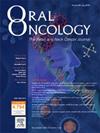开发一种基于患者报告结果的机器学习模型来预测头颈癌的复发
IF 4
2区 医学
Q1 DENTISTRY, ORAL SURGERY & MEDICINE
引用次数: 0
摘要
头颈癌(HNC)患者的复发率很高,早期发现与生存率的提高有关。越来越多的研究发现,患者报告的结果(PROs)可以预测患者的护理需求。在这里,我们研究了针对HNC患者或一般患者的pro是否可以使用机器学习(ML)算法预测疾病进展。方法:本研究分析了1,302例HNC患者,包括在治疗意图治疗后3个月完成至少一项MD安德森症状量表(MDASI)或埃德蒙顿症状评估评分(ESAS)问卷的患者。ML模型,包括最小绝对收缩和选择算子(LASSO)逻辑回归和随机森林(RF),应用于基线或纵向PRO变化来预测复发。通过接受者操作曲线下的面积评估预测性能,通过10倍交叉验证计算。计算相对变量重要性,平均降低每棵树的袋外预测精度。结果HNC患者的复发率为9.5%(123例)。基线治疗后MDASI, RF模型显示曲线下面积(AUC)接近0.675,灵敏度为0.83,特异性为0.58,疼痛,言语和口干为关键变量。当按HPV状态对患者进行分层时,我们基于疼痛、焦虑和情绪的非HPV模型在3个月时的AUC为0.71,在6个月时为0.70。结论使用HNC特异性pro的ml模型可以识别疾病进展高危患者,准确度中等。需要更大数据集的前瞻性研究和进一步分析来完善这些模型并评估其指导治疗后监测的潜力。本文章由计算机程序翻译,如有差异,请以英文原文为准。
Development of a patient reported outcomes based machine learning model to predict recurrences in head and neck cancer
Introduction
Recurrence rates among Head and Neck Cancer (HNC) patients are high, with earlier detection associated with improved survival. Patient-reported outcomes (PROs) have increasingly been found to predict patient care needs. Here, we examine whether PROs specific to HNC patients or general can predict disease progression using Machine Learning (ML) algorithms.
Methods
This was an analysis of 1,302 HNC patients, including patients who completed at least one MD Anderson Symptom Inventory (MDASI) or Edmonton Symptom Assessment Score (ESAS) questionnaire 3 months following curative intent treatment. ML models, including least absolute shrinkage and selection operator (LASSO) logistic regression and Random Forest (RF) were applied to baseline or longitudinal PRO changes to predict recurrences. Predictive performances were assessed via area under the receiver-operating curve, computed with 10-fold cross-validation. Relative variable importance were computed with average decrease in out-of-bag prediction accuracy of each tree.
Results
Disease recurrence occurred in 9.5 % (n = 123) of HNC patients. Baseline post-treatment MDASI, RF models demonstrated an area under the curve (AUC) approximating 0.675, sensitivity of 0.83 and specificity of 0.58 with pain, speech, and dry mouth as key variables. When stratifying patients by HPV status, our non-HPV model based on pain, distress, and mood yielded an AUC of 0.71 at 3 months and 0.70 at 6 months.
Conclusion
ML models using HNC specific PROs can identify patients at high risk for disease progression with moderate accuracy. Prospective studies with larger dataset and further analysis are needed to refine these models and evaluate their potential in guiding post-treatment surveillance.
求助全文
通过发布文献求助,成功后即可免费获取论文全文。
去求助
来源期刊

Oral oncology
医学-牙科与口腔外科
CiteScore
8.70
自引率
10.40%
发文量
505
审稿时长
20 days
期刊介绍:
Oral Oncology is an international interdisciplinary journal which publishes high quality original research, clinical trials and review articles, editorials, and commentaries relating to the etiopathogenesis, epidemiology, prevention, clinical features, diagnosis, treatment and management of patients with neoplasms in the head and neck.
Oral Oncology is of interest to head and neck surgeons, radiation and medical oncologists, maxillo-facial surgeons, oto-rhino-laryngologists, plastic surgeons, pathologists, scientists, oral medical specialists, special care dentists, dental care professionals, general dental practitioners, public health physicians, palliative care physicians, nurses, radiologists, radiographers, dieticians, occupational therapists, speech and language therapists, nutritionists, clinical and health psychologists and counselors, professionals in end of life care, as well as others interested in these fields.
 求助内容:
求助内容: 应助结果提醒方式:
应助结果提醒方式:


